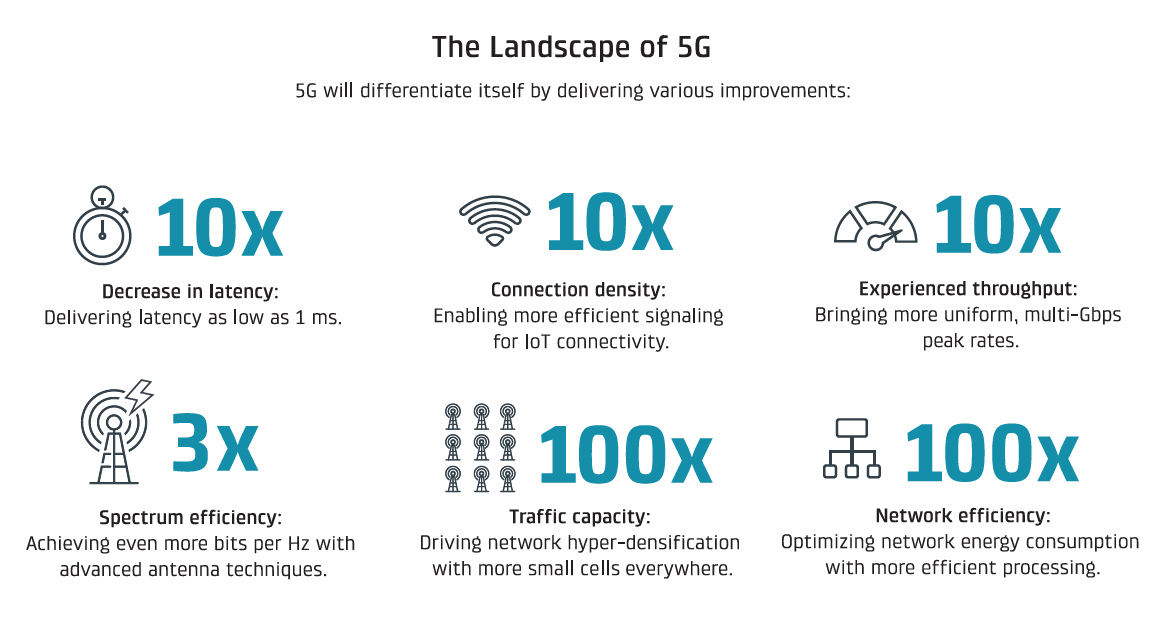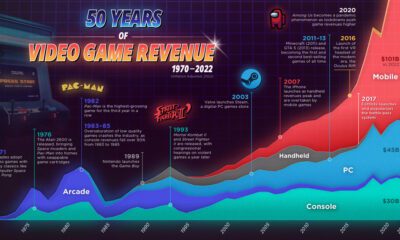Technology
5G: The Next Generation of Mobile Connectivity
Just before the smartphone revolution, Nokia was by far the world’s most popular mobile handset manufacturer.
However, despite selling 250 million units of its two most popular block-shaped models in the mid-2000s, the Finnish company ended up being woefully late to the smartphone party. Not only was the company ill-equipped to match the iPhone and Blackberry in terms of technology and design features, but Nokia also failed to foresee how exponential advances in mobile connectivity would change how people ultimately used their devices.
As true broadband connectivity shaped the mobile experience, the phone was no longer just a phone – it was transformed into a seamless hub for any and all digital activity.
The 5G Experience
In the coming years, the newest generation of mobile connectivity – 5G – will roll out and change what is possible again. With maximum speeds up to 1,000x faster than 4G, this new technology will again shift consumer behavior, as well as how we view smartphones, communications, IoT, gaming, and AR/VR.
Today’s infographic comes to us from Cradlepoint, and it highlights how the switch to 5G is unfolding, and what it could mean to you.

The switch to 5G is already well underway, with countries like China and the United States spending billions of dollars since 2015 to get infrastructure in place.
And by 2035, it’s estimated that 5G will enable $12.3 trillion of global economic output, according to a recent report from IHS Markit.
What 5G Will Mean
Here are some of the key differentiators that 5G will provide to future wireless connectivity:
10x decrease in latency
Latency will be as low as 1ms.
10x increase in connection density
This will enable more efficient signaling for IoT connectivity.
3x spectrum efficiency
More bits per Hz will be achieved with advanced antenna techniques.
100x traffic capacity
This will drive network hyper-densification with more small cells everywhere.
10x experienced throughput
Multi-Gbps peak rates will be achieved with uniformity.
100x network efficiency
Network energy consumption will be optimized through more efficient processing.
The switch to 5G will mean longer battery life for devices, lower costs, enhanced cellular footprints, higher throughput, enhanced capacity, low latency, and virtually no packets dropped.
More importantly, as a result of these changes, how mobile connectivity looks in 10 years may be as unrecognizable as the Nokia block phone era does to us today.
Technology
Ranked: Semiconductor Companies by Industry Revenue Share
Nvidia is coming for Intel’s crown. Samsung is losing ground. AI is transforming the space. We break down revenue for semiconductor companies.
Semiconductor Companies by Industry Revenue Share
This was originally posted on our Voronoi app. Download the app for free on Apple or Android and discover incredible data-driven charts from a variety of trusted sources.
Did you know that some computer chips are now retailing for the price of a new BMW?
As computers invade nearly every sphere of life, so too have the chips that power them, raising the revenues of the businesses dedicated to designing them.
But how did various chipmakers measure against each other last year?
We rank the biggest semiconductor companies by their percentage share of the industry’s revenues in 2023, using data from Omdia research.
Which Chip Company Made the Most Money in 2023?
Market leader and industry-defining veteran Intel still holds the crown for the most revenue in the sector, crossing $50 billion in 2023, or 10% of the broader industry’s topline.
All is not well at Intel, however, with the company’s stock price down over 20% year-to-date after it revealed billion-dollar losses in its foundry business.
| Rank | Company | 2023 Revenue | % of Industry Revenue |
|---|---|---|---|
| 1 | Intel | $51B | 9.4% |
| 2 | NVIDIA | $49B | 9.0% |
| 3 | Samsung Electronics | $44B | 8.1% |
| 4 | Qualcomm | $31B | 5.7% |
| 5 | Broadcom | $28B | 5.2% |
| 6 | SK Hynix | $24B | 4.4% |
| 7 | AMD | $22B | 4.1% |
| 8 | Apple | $19B | 3.4% |
| 9 | Infineon Tech | $17B | 3.2% |
| 10 | STMicroelectronics | $17B | 3.2% |
| 11 | Texas Instruments | $17B | 3.1% |
| 12 | Micron Technology | $16B | 2.9% |
| 13 | MediaTek | $14B | 2.6% |
| 14 | NXP | $13B | 2.4% |
| 15 | Analog Devices | $12B | 2.2% |
| 16 | Renesas Electronics Corporation | $11B | 1.9% |
| 17 | Sony Semiconductor Solutions Corporation | $10B | 1.9% |
| 18 | Microchip Technology | $8B | 1.5% |
| 19 | Onsemi | $8B | 1.4% |
| 20 | KIOXIA Corporation | $7B | 1.3% |
| N/A | Others | $126B | 23.2% |
| N/A | Total | $545B | 100% |
Note: Figures are rounded. Totals and percentages may not sum to 100.
Meanwhile, Nvidia is very close to overtaking Intel, after declaring $49 billion of topline revenue for 2023. This is more than double its 2022 revenue ($21 billion), increasing its share of industry revenues to 9%.
Nvidia’s meteoric rise has gotten a huge thumbs-up from investors. It became a trillion dollar stock last year, and broke the single-day gain record for market capitalization this year.
Other chipmakers haven’t been as successful. Out of the top 20 semiconductor companies by revenue, 12 did not match their 2022 revenues, including big names like Intel, Samsung, and AMD.
The Many Different Types of Chipmakers
All of these companies may belong to the same industry, but they don’t focus on the same niche.
According to Investopedia, there are four major types of chips, depending on their functionality: microprocessors, memory chips, standard chips, and complex systems on a chip.
Nvidia’s core business was once GPUs for computers (graphics processing units), but in recent years this has drastically shifted towards microprocessors for analytics and AI.
These specialized chips seem to be where the majority of growth is occurring within the sector. For example, companies that are largely in the memory segment—Samsung, SK Hynix, and Micron Technology—saw peak revenues in the mid-2010s.
-

 Green2 weeks ago
Green2 weeks agoRanked: Top Countries by Total Forest Loss Since 2001
-

 Travel1 week ago
Travel1 week agoRanked: The World’s Top Flight Routes, by Revenue
-

 Technology1 week ago
Technology1 week agoRanked: Semiconductor Companies by Industry Revenue Share
-

 Money2 weeks ago
Money2 weeks agoWhich States Have the Highest Minimum Wage in America?
-

 Real Estate2 weeks ago
Real Estate2 weeks agoRanked: The Most Valuable Housing Markets in America
-

 Markets2 weeks ago
Markets2 weeks agoCharted: Big Four Market Share by S&P 500 Audits
-

 AI2 weeks ago
AI2 weeks agoThe Stock Performance of U.S. Chipmakers So Far in 2024
-

 Automotive2 weeks ago
Automotive2 weeks agoAlmost Every EV Stock is Down After Q1 2024














